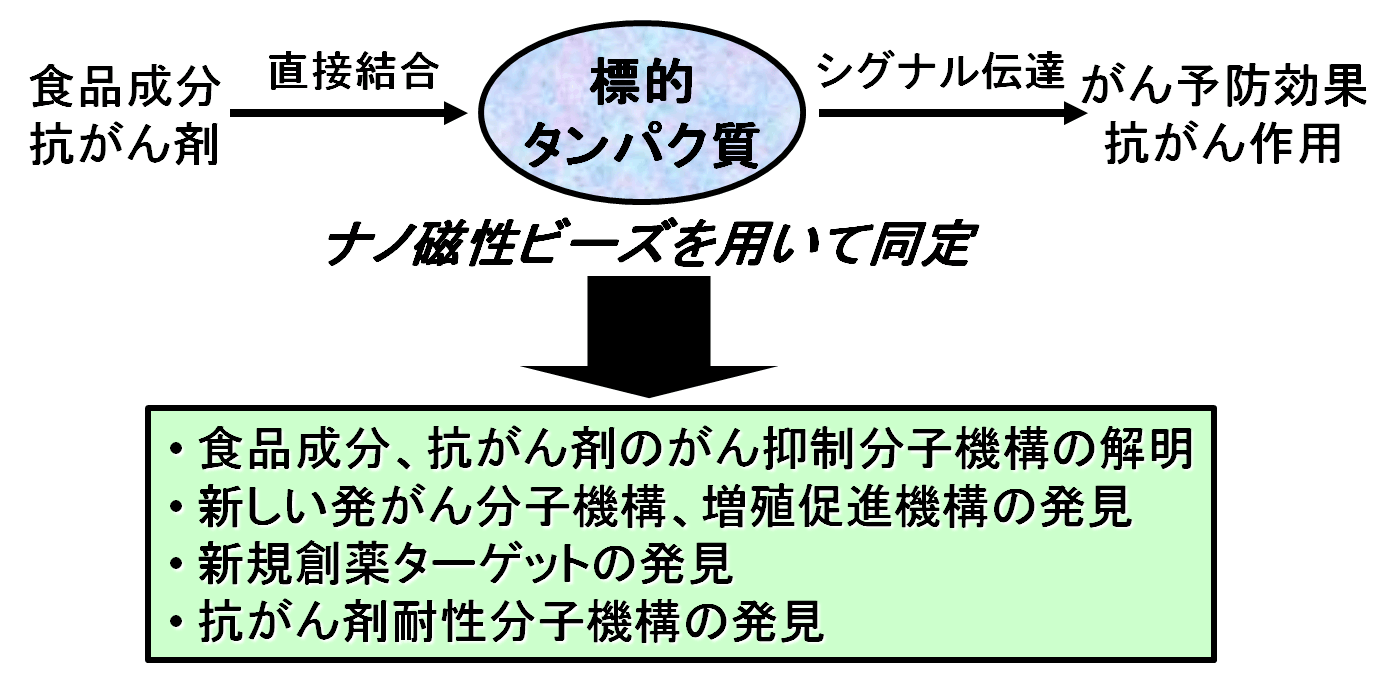ケミカルバイオロジー
食品成分、抗がん剤を用いたケミカルバイオロジー研究

私たちは、東京工業大学の半田宏研究室で開発されたナノ磁性ビーズ(1, 2)を用いて、ケミカルバイオロジー研究を行っている。このビーズを用いることで、生理活性物質や医薬品の直接の標的タンパク質を同定し、作用機序を解明することができる。実際に、サリドマイドによる催奇形性の分子メカニズムの解明がなされた(3)。私も、このビーズを用いて、病原性大腸菌の感染メカニズムの一端を明らかにしている(4)。
現在、抗がん作用を有している食品成分(ポリフェノールやカロテノイドなど)の標的タンパク質を、このナノ磁性ビーズと質量分析計を用いて同定している。そして、これらの食品成分の詳細な作用機序が明らかになってきている。さらには、これらの食品成分結合タンパク質の機能解析を通して、新しい発がん分子機構や増殖促進機構も明らかになってきている(5-7)。また、作用機序が未知の抗がん剤の標的タンパク質の同定や、抗がん剤に対する耐性メカニズムの解明も試みている。さらには、他大学との共同研究においても、標的タンパク質の探索と同定を行っている。
文責: 飯泉陽介
- (1) Shimizu N., et al., (2000) High-performance affinity beads for identifying drug receptors.
Nature Biotechnology 18:877-881. - (2) Nishio K., et al., (2008) Development of novel magnetic nano-carriers for high-performance affinity purification. Colloids Surf B Biointerfaces 64:162-169.
- (3) Ito T., et al., (2010) Identification of a primary target of thalidomide teratogenicity.
Science 327:1345-1350. - (4) Iizumi Y., et al., (2007) The enteropathogenic E. coli effector EspB facilitates microvillus effacing and antiphagocytosis by inhibiting myosin function.
Cell Host & Microbe 2:383-392. - (5) Iizumi Y., et al., (2013) The flavonoid apigenin downregulates CDK1 by directly targeting ribosomal protein S9. PLoS One 8:e73219.
- (6) Oishi M., et al., (2013) Apigenin sensitizes prostate cancer cells to Apo2L/TRAIL by targeting adenine nucleotide translocase-2. PLoS One 8:e55922.
- (7) Taniguchi T., et al., (2016) Resveratrol directly targets DDX5 resulting in suppression of the mTORC1 pathway in prostate cancer. Cell Death & Disease 7:e2211.
